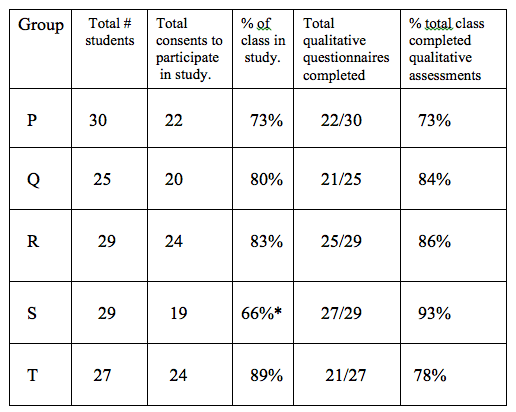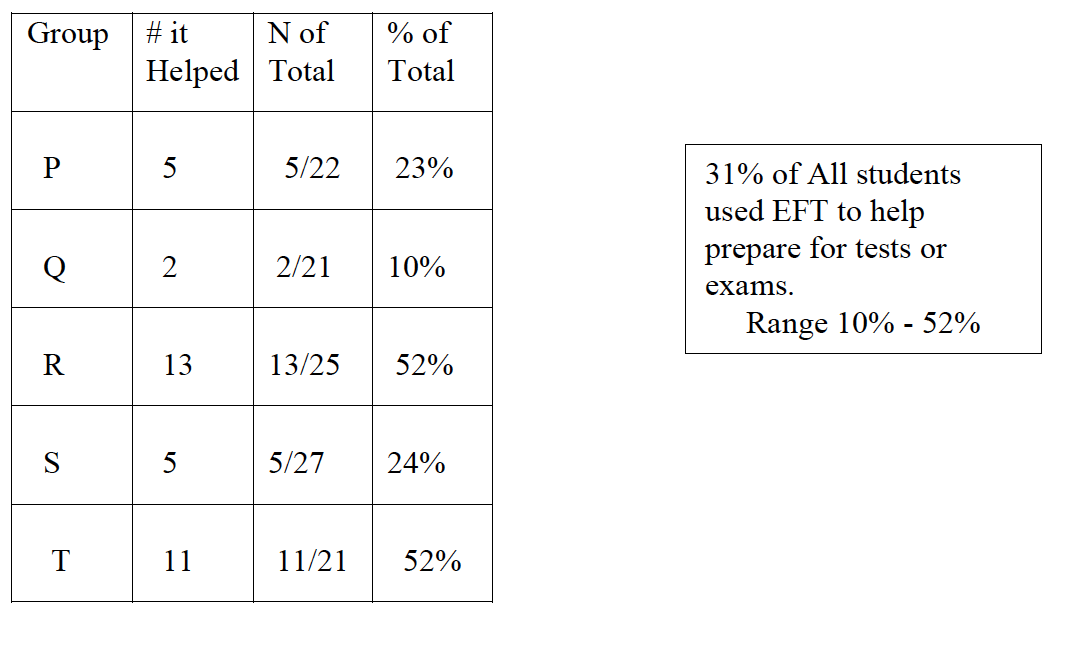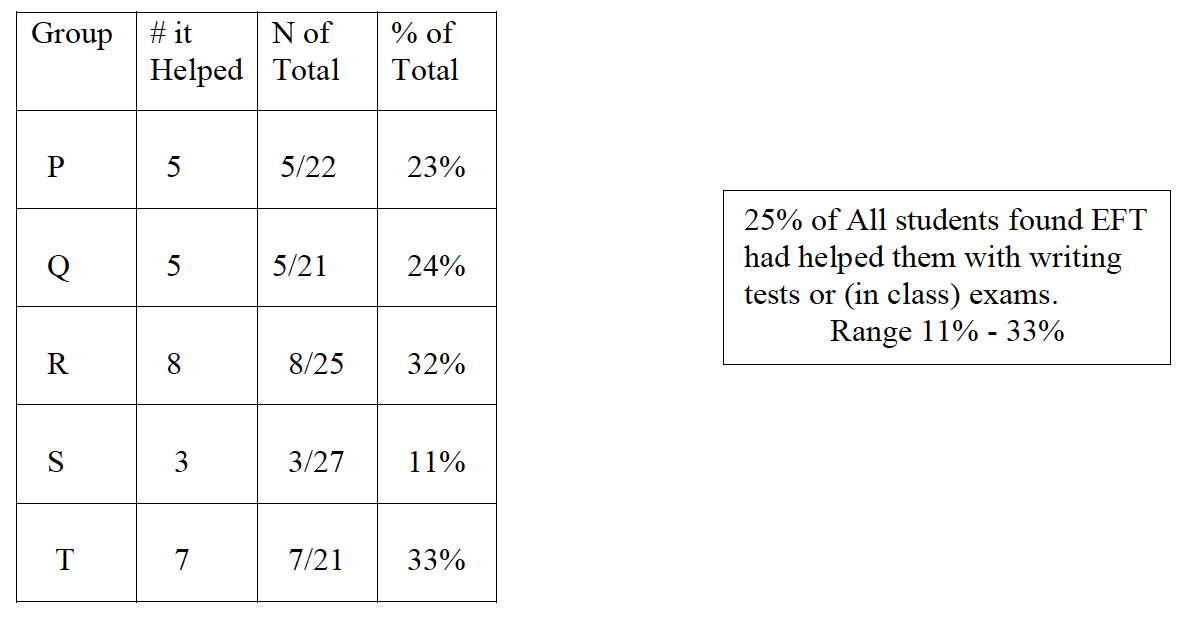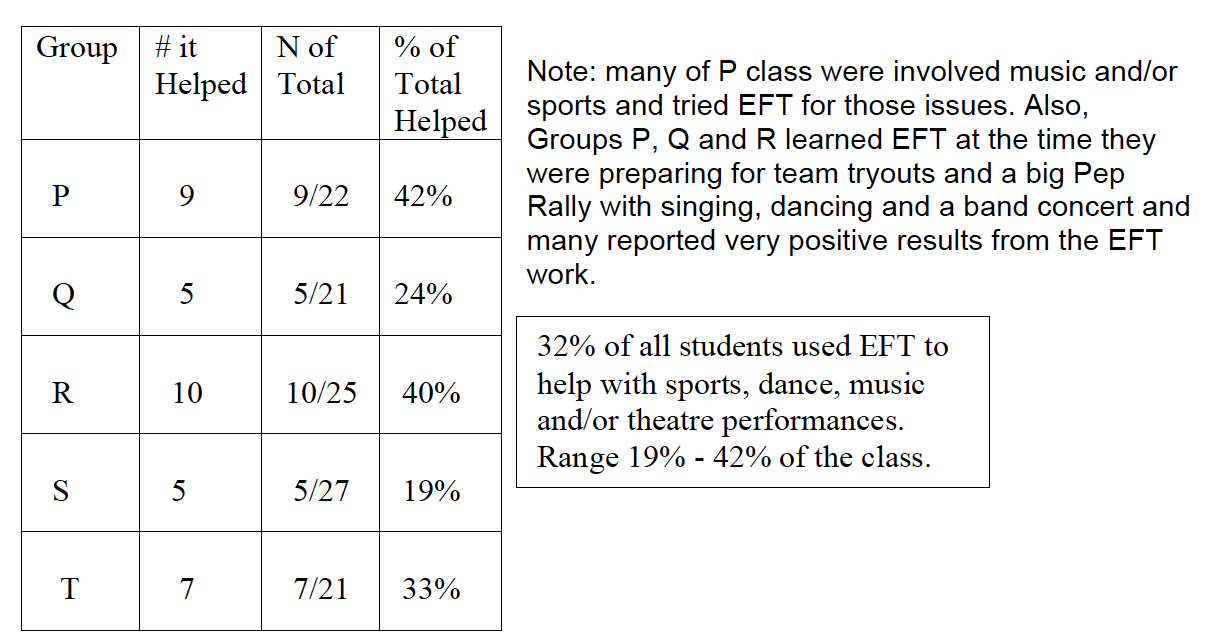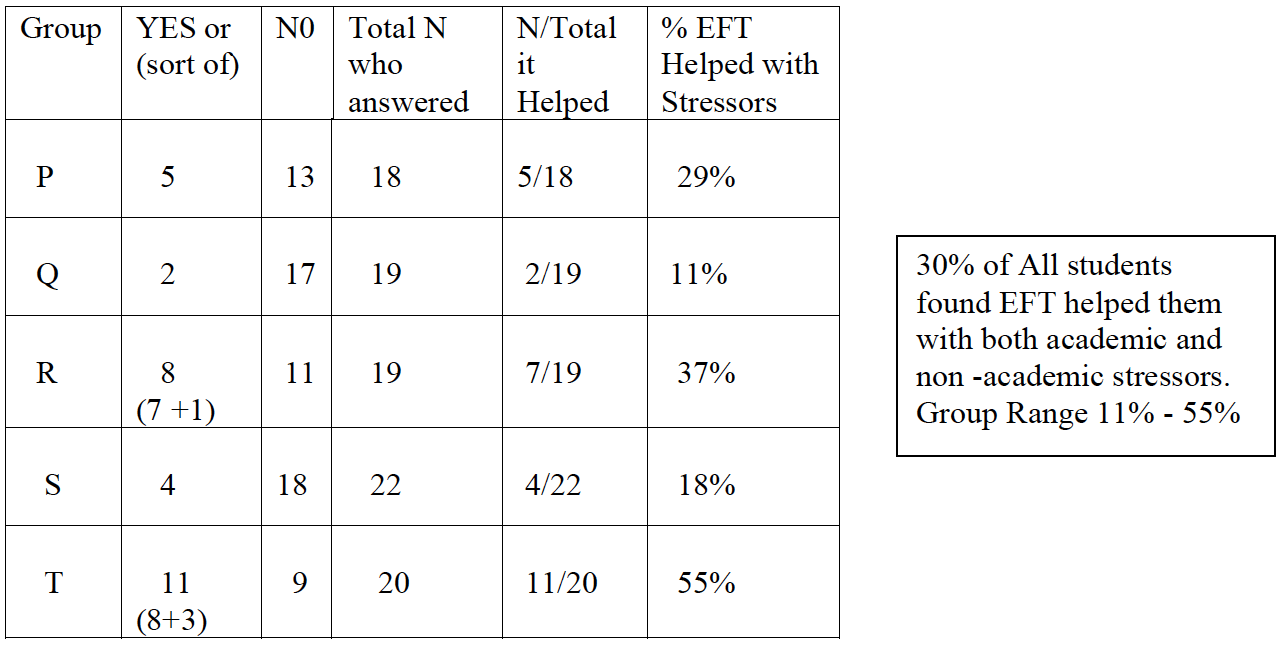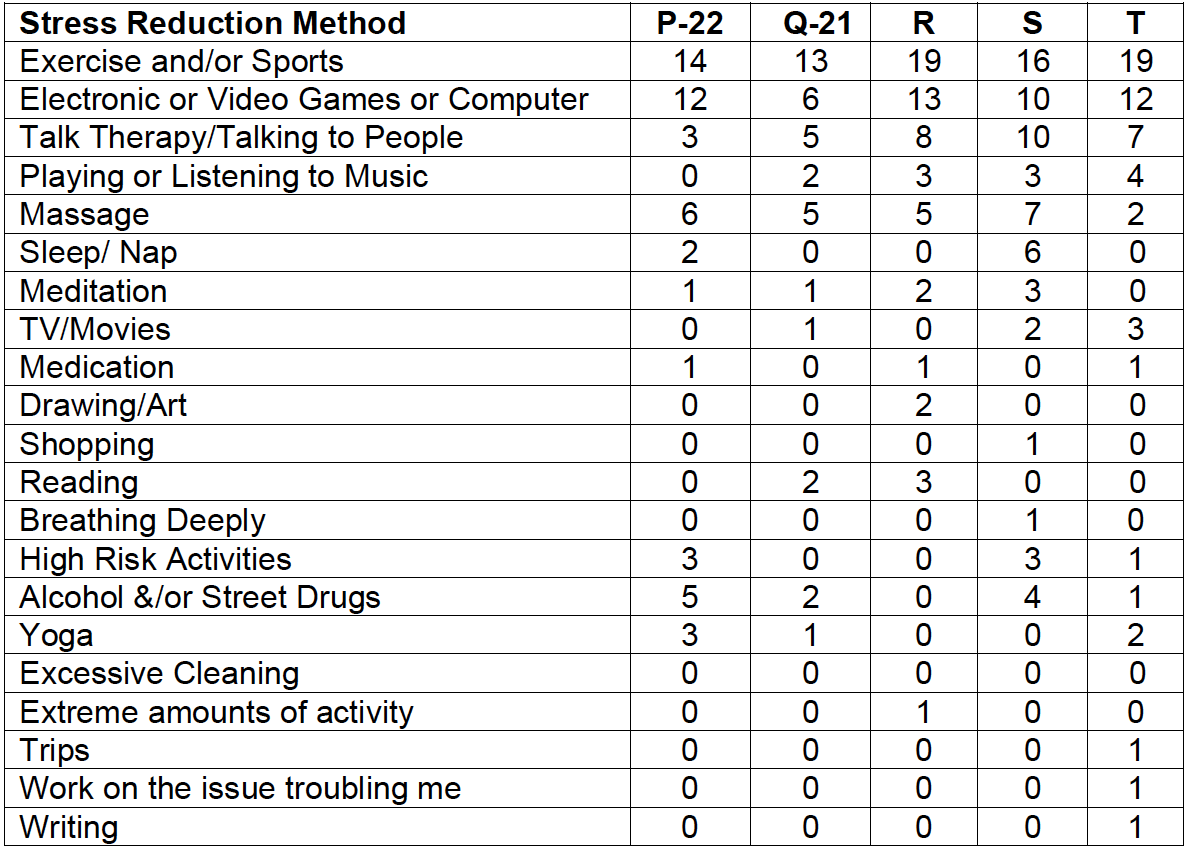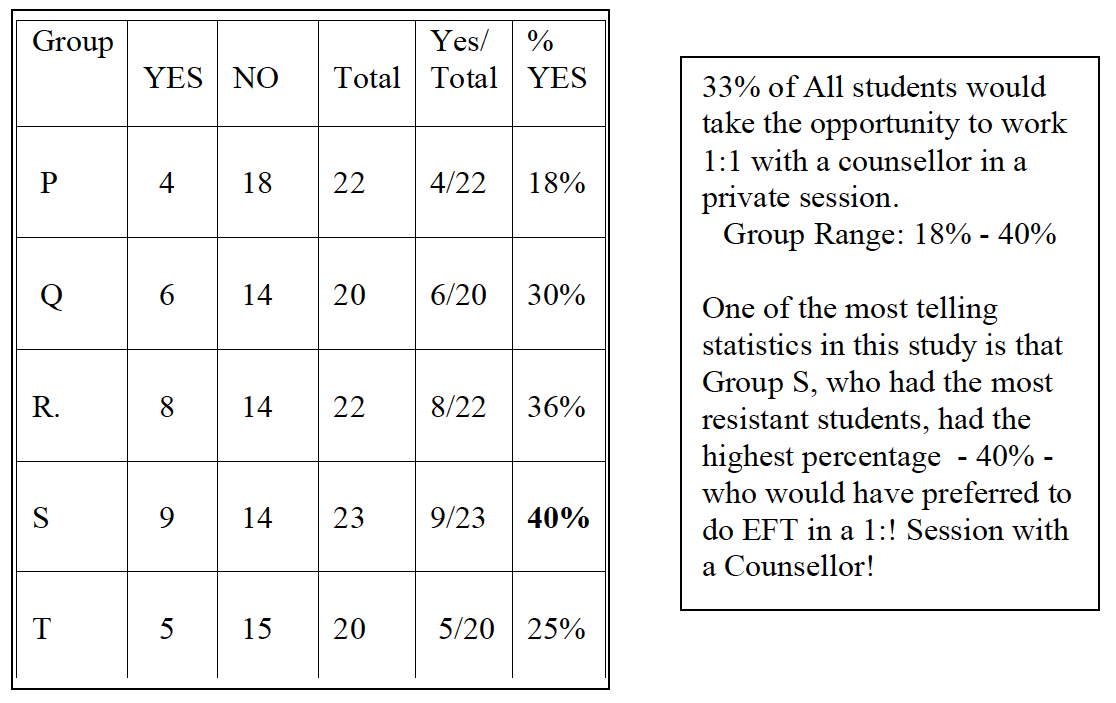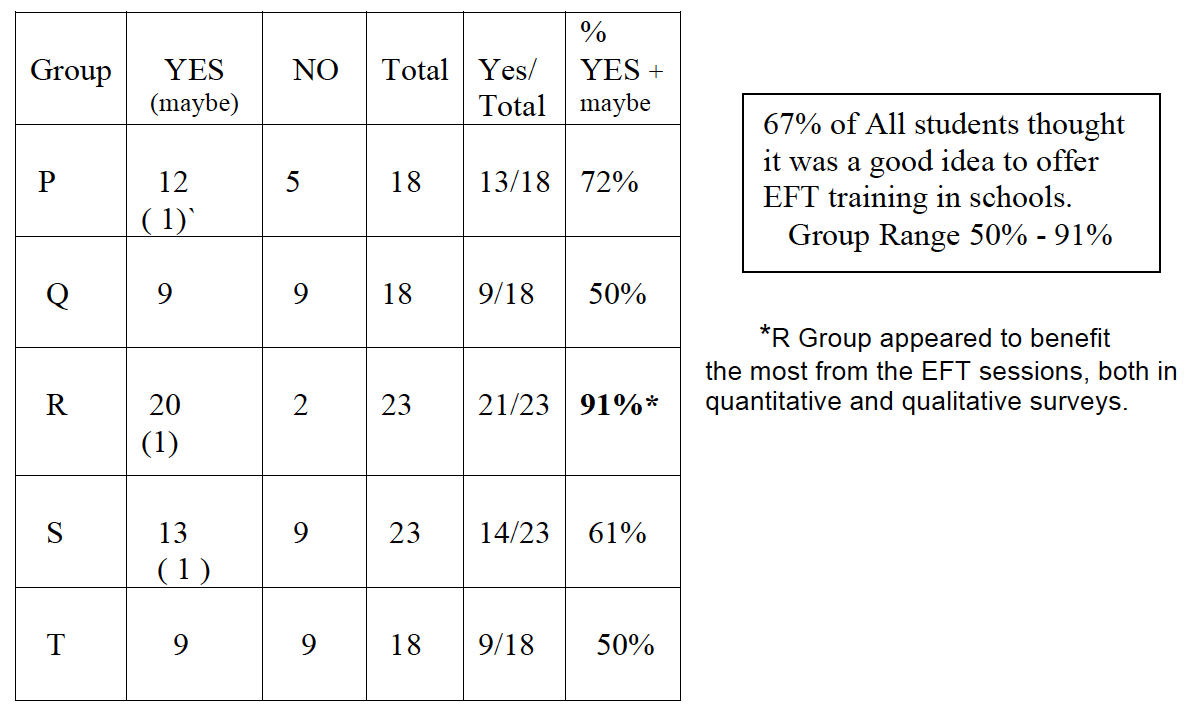Abstract
Objective: This 2008 Feasibility Study explored the impact of teaching Emotional Freedom Technique(EFT) as part of class curriculum for Secondary School students, as a self-care tool for reducing stress and test anxiety and for enhancing coping skills.
Participants: Canadian students at a Secondary School taking Planning 10 courses, with combined Grades 10, 11 & 12, (n = 138) participated in the study. All students received the EFT training as part of class curriculum, and completed all the questionnaires.
Methods : An initial controlled trial of EFT for 2 class groups (total n = 44) is compared to no treatment for 2 class groups (total n = 43).. Standardized quantitative measures were taken of stress (Perceived Stress Scale) coping strategies (Brief COPE) and test anxiety (Westside TA), prior to Intervention; one week after the first class; and following the completion of the EFT training sessions.
Following the Controlled Study and prior to Christmas exams, the No Treatment classes were given the same number of hours training in EFT as the Intervention Group. A fifth class which could not be used in the controlled study, was taught EFT during the initial time period. Because all students had to participate in the EFT training to get school credit, Quantitative measures were taken for all students at all time periods; including just after the EFT training of the control groups prior to Christmas break, and before Provincial Exams in January.
An 18 item, anonymous, Quantitative questionnaire was administered at the conclusion of the EFT training for all Groups.
Results : Putting together a research proposal, designing the study; jumping through the hoops of permissions, and institution rules; carrying out the interventions; collecting the data and reporting the results are all monumental tasks. Things can go wrong at any juncture, and often do. However, the one issue I didnt think would occur was that the Quantitative Data would be virtually useless. I was also surprised by the wide range of response and results of the various Class Groups, as detailed below, given that they were all offered almost identical EFT training.
Due to a number of unfortunate circumstances, none of the Quantitative Data could be considered clearly valid. There were two main reasons. 1. The Principal Investigators were not notified that many of the students would not be taking exams during the trial period and approximately 25% of the foreign students did not have to write exams at all. This meant that collecting data on Test Anxiety was irrelevant for many. 2. Contamination of the Quantitative questionnaires occurred with some students checking off multiple choice answers in patterns on the answer checkboxes, and it was not clear how many other students had done this, but perhaps not in as blatant a manner as to be detected. This data loss was exceedingly disappointing for all involved.
Fortunately, valuable findings were still gleaned from student responses to the 18 item Qualitative Questionnaire, submitted anonymously by all students at the end of EFT Study. Perhaps because these surveys encouraged both positive and negative feedback and could not be tracked to individuals, the students appeared to be more open and direct – (sometimes brutally). But they offered useful and constructive information on many levels. Most encouraging was that 67% of students recommended that EFT be taught in schools; 63% indicated they could benefit from learning EFT in smaller groups, and 33% indicated they would be interested in having 1:1 assistance from a Counsellor using EFT.
While some students were resistant to the EFT classes, the majority shared clear examples of how they had taken their EFT skills into coping with: homework, studying, assignments, and sports and arts performances. In addition, some were able to expand their use of EFT to family and social relationships, and other issues outside the school setting, which was clear evidence of enhanced coping skills.
Conclusions: The teaching of EFT in schools can benefit some students; particularly those who are motivated to learn it due to need or interest. It is recommended that more research, investigation and refinement of teaching EFT in schools, to a range of grades; to whole classes and to smaller groups of students seeking specific help for anxiety and stress be undertaken.
Introduction
Anxiety and stress are common issues for most students, at least some of the time. For some students, these issues increase when they are facing scholastic evaluation, such as exams, presentations or performances. Estimates are that between 20 35% of high school students demonstrate either severe or high test anxiety. In the Canadian Province of British Columbia, a 2018 study (McCreary Centre Society, 2019) of 38,015 students aged 12 18 years, found that 86% reported feeling stressed in the past month, and 30% reported mental health conditions including: anxiety disorder, panic attacks or depression. In addition to lowering exam scores, such anxiety can negatively impact general school performance, health and well-being and even future career choice.
EFT is one of a new group of therapies known as energy psychotherapies. These therapies utilize a variety of methods that pair negative emotions/ thoughts/ memories with tapping or holding acupressure relaxation points on the face, hands and body. Resulting physiologic changes such as relaxation, emotional calming and enhanced thinking are common results of these therapies.
EFT can be used as a self-care tool or under the direction of a trained therapist, to reduce or alleviate many negative issues; including specific anxieties and stresses. While many therapists using EFT for school anxiety issues have reported it to be highly effective in 1:1 therapy, and anecdotal reports of classroom use have also been positive, only a few formal, scientific studies had been undertaken prior to 2008, when this study was done.
A Turkish Study (Sezgin and zcan, 2009)) compared the use of EFT to Progressive Muscle Relaxation (PMR) in reducing test anxiety for students who had high test anxiety scores, and were preparing for state university entrance exams. Results indicated that while both the EFT tapping procedure and PMR technique have been found to be effective in decreasing the test anxiety measured by a Test Anxiety Inventory TAI])); the EFT technique had significantly more decrease in TAI scores compared to the PMR technique.
In a 2007 Pilot study (Benor, Ledger and Toussaint 2009) 15 University students with high to severe levels of test/performance anxiety were divided into three small groups. Groups received either two, 2-hour group sessions of EFT or WHEE (a hybrid combining EFT & EMDR), or five, 2-hour sessions of Cognitive Behavioral Therapy (CBT). All groups, for each of the Therapies in the study had an average drop of 19.6% in Test /Performance Anxiety. However it is note-able that the EFT and WHEE students achieved these results in four hours of group treatment vs ten hours of CBT. The EFT & WHEE groups also tended to use the learned modalities for other significant stressors in their lives, whereas the CBT students did not.
Since 2009, when the present Feasibility Study was completed, there have been at least six additional studies published, demonstrating the effectiveness of EFT for student issues related to: stress (Rogers and Sears, 2015; Church, Yount and Brooks, 2012) class presentations (Boath, Stewart and Carryer, 2013); anxiety & stress symptoms in nursing students (Librizzi-Patterson, 2016) and basketball performance (Church, 2009). As of 2019, there are over 100 Studies of Energy Psychotherapies published in Peer Reviewed Journals. These studies indicate that EP approaches are highly effective for treating: Depression, Anxiety, Food Cravings, Pain, Trauma and Post Traumatic Stress Disorder. For more information visit the ACEP website (see Refs), especially the sections on Resources and EP Research.
Objectives
Given the fact that the majority of students experience stress and anxiety at some times and that these issues can affect performance and well-being, it was proposed that teaching a simple stress-reduction tools such as EFT, to all students, could provide a self-care method for reducing stress and test anxiety and enhance coping skills.
Method
The primary investigator/EFT instructor presented an overview of the study purpose and method to 5 class groups totalling 140 students. A total of 109 students in 5 classes submitted informed consents signed by themselves and a parent/guardian, agreeing to participate in the study. Because of class scheduling issues, only 4 of the 5 class groups could be included in the formal study. These 4 classes were grouped by time schedule and then randomly assigned to either control or intervention groups. The fifth class was offered and took part in the EFT training but were not included in the formal Quantitative study.
At the start of the study, all students received a handout Student Guidelines for Test Anxiety and Test Taking adapted from Humboldt State University Guidelines. This was to give all students some opportunity to consider general steps to reduce anxiety related to tests. The EFT Intervention Group received 4 class sessions of EFT, including an initial class describing stress, stress indicators and effects on thinking and performance, and information on some of the possible benefits of learning EFT. Each class was approximately 80 minutes in length and held once a week, over a 4 week period. Home practice of EFT was encouraged and students were also encouraged to demonstrate EFT to a family member or friend as a way to solidify their learning. The Control Group classes had no contact with the investigator during this time.
Measures
All students in all 5 classes were tested at 5 time periods on three quantitative scales. Regretfully, we were unable to use data from these tests, due to a number of unfortunate circumstances. None of the Quantitative Data could be considered clearly valid. There were two main reasons. 1. The Principal Investigators were not notified that many of the students would not be taking exams during the trial period and approximately 25% of the foreign students did not have to write exams at all. This meant that collecting data on Test Anxiety was irrelevant for many. 2. Contamination of the Quantitative questionnaires occurred with some students checking off multiple choice answers in patterns on the answer checkboxes, and it was not clear how many other students had done this, but perhaps not in as blatant a manner as to be detected. This data loss was exceedingly disappointing for all involved.
Following the completion of all 5 class groups being taught EFT, students were asked to anonymously complete an 18 question Qualitative Questionnaire. It is felt by this Investigator that the data from the Qualitative Survey provided the most valuable information from the Study, as it allowed students to share their unique, individual experiences and provide personal perspectives on how EFT could be taught more effectively in schools. Responses to questions, asked about specific students stressors and methods of coping were of value to School personnel, but are not included in this report.
One of the fascinating aspects of learning for the primary investigator, was the variation in attitudes towards the EFT instruction by each of the 5 Class groups. One group, in particular, was very positive and reported the most benefits. Another group, was mainly negative from the start with only 66% of the class even participating with signed consents, compared with between 73% and 89% of students with signed consents in the other classes. This class with the lowest participation also made the most negative comments about learning EFT and were the most disruptive and difficult to engage.
Comments by the individual teachers working with each of these different Class groups verified that the personality factor of each Group had been established early in the year, and affected their overall experiences of teaching these students.
Despite the resistant attitude of some of the students, between 50% and 91% of all class members felt it was a good idea to teach EFT in schools. In addition, between 51% and 75% of class members indicated they would have found it easier to do EFT in a smaller group. The majority suggested that EFT should be introduced in Grades 3 – 6, when “students would be less self-conscious” and “more open to participating,” However the most positive and highly participatory Class members suggested high school was the best time because of the heavier pressures in those grades.
The EFT Instructor/Investigator found that peer pressure, particularly in the most negatively predisposed class group, was a significant handicap to students who wanted to participate fully. These students could have benefited much more if it had not been for disruptive and/or derisive peers. Many students commented on this issue in their written feedback.
One item not directly related to the use of EFT but which it seemed important to ask, was what other methods of stress reduction students were using for themselves. We were impressed by the fact that the majority of students in all classes were using exercise of various sorts, as their main stress reduction techniques. This was followed and almost matched by Computer and video games. Given studies that indicate both electronic games and exercise can create endorphins in the brain, it seems that students are drawn to stress reduction methods that stimulate physiologic feelings of wellbeing. I think this speaks very well to the school system’s promotion and support of sports and exercise by their students and gives some understanding for the attraction to electronic gaming.
Due to a number of unfortunate circumstances, none of the Quantitative Data could be considered clearly valid. There were two main reasons. 1. The Principal Investigators were not notified that many of the students would not be taking exams during the trial period and approximately 25% of the foreign students did not have to write exams at all. This meant that collecting data on Test Anxiety was irrelevant for many. 2. Contamination of the Quantitative questionnaires occurred with some students checking off multiple choice answers in patterns on the answer checkboxes, and it was not clear how many other students had done this, but perhaps not in as blatant a manner as to be detected. This data loss was exceedingly disappointing for all involved.
Data summary
Table 1. Percents of students participating per class Group
*Note: The fact that 1/3 of the S Class did not get signed consents to participate in this Study could have reflected some of the reason that there was a high degree of negativity in this group. They were the most disruptive during the classes, made the most negative comments and had the worst response to the teachings overall. However, they had the highest rate of return on the Qualitative questionnaires.
Question 1. How often have you used the EFT that you learned in your Planning 10 Class?
Question 2. Did you find that EFT has helped you with: studying and preparing for tests or exams?
Question 3. Did you find that EFT has helped you with writing tests or exams?
Question 4. Did you find that EFT has helped you with: performing (music, sport, dance, theatre, speaking)
Question 5. Do you find that EFT has helped you with self-acceptance?
Question 6. What other life stressors have you been dealing with this term, which may have contributed to your stress load with studies and preparation for exams?
(*BOLD indicates a high percentages of students checked these categories)
*School work load/grades/exams
*Family Issues
*Relationship issues
*Health Issues
Parent expectations
Teacher Issues
Job
Public Speaking
Sports/Teams with teachers
Musical performances/exams
Learning new languages
Finances
Anxiety/ depression
Low self-esteem
The PI would also note that a large percentage of the students said they felt tired and hungry, on their recording sheets, after tapping. My hunch is they were not eating well and not getting enough sleep, which is also affecting their participation.
Question 7. Has your learning and use of EFT helped you with these stressors and/or other areas of your life?
If you used EFT for stressors, please share some examples.
When overwhelmed, it clears my head
More rational response
More calm over an upsetting exam result
Tests it helped
Mom yelling at me and I tapped to relax myself
When my parents and I were upset
I tapped on my head, because it seemed to be an area that worked well.
A piano concert. I was really nervous while waiting for my turn.
It made me calmer about my (stressors) issues.
Calm in tests.
It makes me concentrate during my games
My drivers exam
use it before I sleep sometimes
I am more apathetic towards some situations
It helped me study for tests
I felt much more confident about myself.
It helped me if I was angry at someone.
It lets me know I am successful.
I can think clearly when nervous and I dont get clammy hands when all the attention is on me.
8. What other stress reduction methods have you been using this term?
*Note: It is interesting that research indicates both exercise and video games can increase endorphins, which may be the reason the majority of students chose one or both of these activities for stress reduction.
9. Do you think it would be easier for you to learn EFT in a smaller group?
10. If there was an opportunity to have a counsellor help you use EFT in a private session, do you think this would be helpful?
11. Do you think it is a good idea to offer EFT training in schools?
12. What grades do you think would be the best time to introduce EFT to students?
(This question was open ended. The answers have been grouped for ease of analysis.)
*This group had the most male students as well as ADHD behaviour challenges, and ESL/SL students. They worried about peer teasing and thought younger students would feel less concerned about that.
**This is the group that appeared to benefit the most from the EFT sessions, both in quantitative and qualitative surveys. They were engaged learners and serious students. So it makes sense that they would want it in their grades.
13. Is there anything else you would like us to know, both positive or negative, about your experiences as a participant in this Study? Please expand below or on a separate page.
Comments here are from and P Group and R Group (P was the most resistant and R the most participatory) and reflect the range of comments from all Groups:
This is a valuable technique to learn and know.
I thought the aura stuff was just too kooky to be credible.
Students who actually need stress relievers should go to a counsellor and not waste others time.
I dont like doing EFT.
Too much talking.
Be more interactive.
Show more proof medical evidence (Note: studies were explained in almost every class!)
It didnt help the first few times so I stopped.
The descriptions were very well done. (2 students)
I like the little tips of performing and ways you can hide it if around people.
The person who taught us had great energy.
Thank you so much.
A good program and I am glad to be so lucky that you have chosen our school as part of the study. Teach this to as many people as you can!
Recommendations
Qualitative findings from this Study would indicate there can be significant benefits for some students to learn EFT as part of basic curriculum in school. It is recommended that further research be undertaken on the best ages to offer this training and mechanisms for presenting EFT as a stress reduction and coping skill for students. Specific exploration of offering EFT in small groups for students who are specifically seeking assistance for anxiety, stress and enhanced coping skills would also be valuable.
Afternote from the Author
I would like to express my gratitude to all the students I have worked with in various studies, as well as my private practice, for teaching me so much about how simple but powerful EFT can be to reduce stress and enhance success for a wide range of issues.
As a response to the beneficial results I have seen for students instructed in EFT, I have recently completed a Student Guide that can be used as the format for Secondary School instruction of EFT, as a self-study format for older students in College or University or with the guidance of parents or counsellors. Reducing Anxiety & Stress to ENHANCE SUCCESS with Emotional Freedom Technique/Tapping. A Student Guide can be purchased at www.amazon.ca or from the authors website: www.karenledger.ca.
References
Association for Comprehensive Energy Psychology (ACEP) www.energypsych.org.
Benor, D. J., Ledger, K., Toussaint, L. (2009). Pilot study of Emotional Freedom Techniques, Wholistic Hybrid derived from Eye Movement Desensitization and Reprocessing & Emotional Freedom Techniques, and Cognitive Behavioral Therapy for Treatment of Test Anxiety in University Students. Explore: The Journal of Science and Healing, 5, 338-340.
Boath, E., Stewart, A., Carryer, A. (2013). Tapping for PEAS. Tapping for Success: A Pilot Study to Explore if Emotional Freedom Techniques (EFT) Can Reduce Anxiety and Enhance Academic Performance in University Students. Innovative Practice in Higher Education.1(3).
Church, D. (2009). The Effect of EFT (Emotional Freedom Techniques) on Athletic Performance. The Open Sports Sciences Journal, 2. 94-99.
Church, D., Yount, G., & Brooks, A. J. (2012). The Effect of Emotional Freedom Techniques (EFT) on Stress Biochemistry: A Randomized Controlled Trial. Journal of Nervous and Mental Disease, 200(10), 891-896.
Librizzi-Patterson, Susan. (2016). The Effect of Emotional Freedom Technique on Stress and Anxiety in Nursing Students: A Pilot Study. Nurse Education Today. 40. 104110.
McCreary Centre Society. (2019). Results of the 2018 BC Adolescent Health Survey. Balance and Connection in BC. The Health and Wellbeing of Our Youth . Vancouver, B.C..29-30.
Rogers, R. & Sears, S. (2015). Emotional Freedom Techniques (EFT) for stress in students: A randomized controlled dismantling study. Energy Psychology: Theory, Research, and Treatment, 7(2). 26-32. doi:10.9769/EPJ.11.1.RR
Sezgin, N. & zcan, B. (2009). The Effect of Progressive Muscular Relaxation and Emotional Freedom Techniques on Test Anxiety in High School Students: A Randomized Controlled Trial . Energy Psychology: Theory, Research, & Treatment. 1(1); 23-30.
